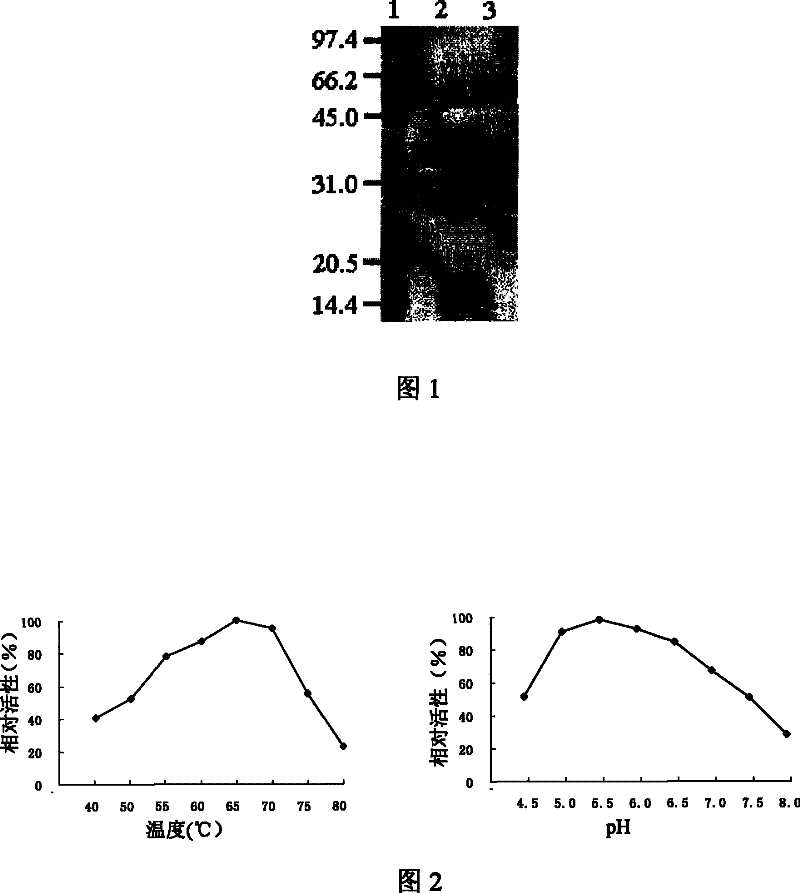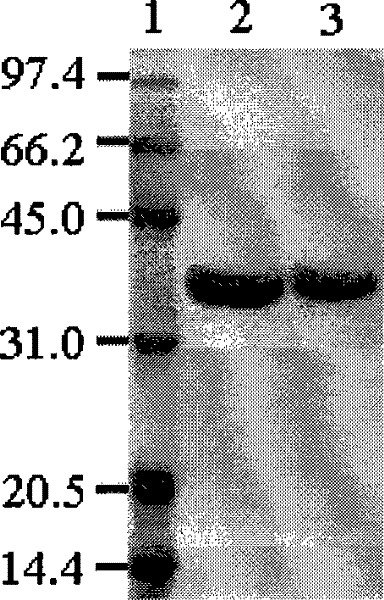Beta-mannanase, gene, preparation method, vector and host cell
A mannanase and host cell technology, applied in the field of beta-mannanase and its encoding gene and preparation, can solve the problems of long fermentation period, difficult to achieve high expression of mannanase gene, unfavorable purification and the like, To achieve the effect of convenient purification
- Summary
- Abstract
- Description
- Claims
- Application Information
AI Technical Summary
Problems solved by technology
Method used
Image
Examples
Embodiment 1
[0035] Example 1. Construction of recombinant plasmid pUC1.17 and transformed strain DH5α (pUC1.17) containing the β-mannanase gene shown in SEQ ID: NO.1
[0036] 2L of water samples were collected from hot springs in Tengchong, Yunnan (pH2, 90°C), filtered through a 0.22 μm microporous membrane (Milipore Company) to collect the bacteria in the water samples, and washed with STE buffer (0.1M NaCl; 10mM Tris-HCl, pH8 .0; 1mM EDTA, pH8.0) to wash the bacteria on the filter membrane, centrifuge at 4000rpm for 10min, and obtain the fresh wet weight of the bacteria about 0.5g. UltraClean for bacteria sediment TM Soil DNA Kit was used to extract total DNA (100 μl, 4 μg / μl), and the ratio of absorbance was determined: A260 / A280=1.947, A260 / A230=2.15. Take 50 μl of the above-mentioned total DNA solution (containing about 200 μg DNA), and digest it with the restriction enzyme Sal I. The enzyme digestion system contains 5 μl Sal I enzyme (20 U / μl), 5 μl Buffer 1 (10 mM KCl, 10 mM Tris...
Embodiment 2
[0037] The construction of embodiment 2.β-mannanase expression vector and transformed bacterial strain:
[0038] According to the nucleotide sequence (manA sequence) shown in SEQ ID: NO.1, synthesize the forward and reverse primers, and the forward primer is 5'GTGC GCTAGC ATGGGACG-3', the underlined part is the restriction site of NheI, and the reverse primer is 5'GCG AAGCTT TCATCGATTTG-3', the underlined part is the restriction site of HindIII. Using these two primers, use the plasmid pUC1.17 as a template, and use the following PCR reaction system (Taq DNA polymerase and its buffer, and dNTP are products from Tiangen Company):
[0039] 10X buffer 5μl
[0040] dNTP 4μl
[0041] Taq DNA polymerase 0.5μl
[0042] Forward primer (25 pM) 1 μl
[0043] Reverse primer (25 pM) 1 μl
[0044] pUC1.17 template (1μg / μl) 1μl
[0045] Reaction conditions: Pre-denaturation at 94°C for 4 minutes, followed by 30 cycles of denaturation at 94°C for 30 seconds, annealing at 50°C for 30...
Embodiment 3
[0046]Example 3. Preparation of Mannanase Gene Mutants
[0047] Using the expression vector pETMan-HA963 of Example 2 as a template, using Stratagene's site-directed mutagenesis kit (QuikChange site-directed mutagenesis kit), referring to the instructions, by introducing mutant bases into the primers and performing PCR amplification, the SEQ ID : The nucleotide sequence shown in NO.1 was mutated from A to C at position 476, and the vector pETMan-E159A containing the mutant was obtained. The nucleotide sequence of the mutant was sequenced by Beijing Nuosai Genome Research Center Co., Ltd., and the result is shown as SEQ ID: NO.3, which realized the preset point mutation, that is, compared with SEQ ID: NO.1, the The nucleotide sequence of the mutant gene is mutated from A to C at position 476, the triplet codon GAA is changed to GCA, and the amino acid Glu at position 159 of the corresponding amino acid sequence (as shown in SEQ ID: NO.4) is changed to Ala. According to the sam...
PUM
 Login to View More
Login to View More Abstract
Description
Claims
Application Information
 Login to View More
Login to View More - R&D Engineer
- R&D Manager
- IP Professional
- Industry Leading Data Capabilities
- Powerful AI technology
- Patent DNA Extraction
Browse by: Latest US Patents, China's latest patents, Technical Efficacy Thesaurus, Application Domain, Technology Topic, Popular Technical Reports.
© 2024 PatSnap. All rights reserved.Legal|Privacy policy|Modern Slavery Act Transparency Statement|Sitemap|About US| Contact US: help@patsnap.com









